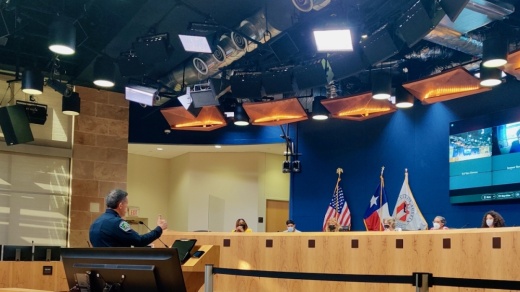Speaking to the commission Nov. 1, Police Chief Joseph Chacon reiterated that APD continues to have a "staffing issue." The struggle to keep a full force has been a years-long trend at APD, and its actual sworn officer count has consistently fallen short of its budgeted totals. Chacon said APD had 1,618 of its 1,809 positions filled as of Oct. 1.
"I have officers leaving and nobody that’s coming back in," he said. Chacon has pointed to attrition at APD, and the prolonged pause and gradual reboot of its cadet academies, as top contributing factors to its staffing totals in his time leading the department.
The completion of APD's "reinvigorated" cadet training program, halfway complete as of early Nov. and continuing under analysis from outside consultants, now remains a top priority, Chacon said.
If passed, Proposition A would require three cadet classes to be held at any time until staffing reaches around 1,950 officers. Only one is currently underway and, barring any delays, the next class is expected to launch in February or March followed by another session in early summer, Chacon said.
Chacon's report to the safety commission also included an overview of crime in Austin, as the city's new record for annual homicides continues to climb with 77 recorded as of the start of November. Overall, however, total crimes against people, property and society—APD's three high-level categories for logging offenses such as violent crimes, robbery and drug crimes, respectively—are all down year-over-year.
Chacon has pointed to gun violence as a central reason behind Austin's homicide spike this year. He also said his gun crime-centered Violence Intervention Program is likely to end soon after a six-plus-month run.
“We will be looking to probably wind that down, and determine what our next intervention program’s going to be," he said.
Funding questions
Proposition A, if passed by voters, would require the city to keep APD staffed at a ratio of at least two police officers per 1,000 Austinites, alongside several other provisions. Regardless of the outcome on Election Day, the city is already planning for the potential cost of bringing on hundreds of new officers.
Depending on APD wages and local population growth, financial staff estimate Austin can expect to spend anywhere from $54.3 million to $119.8 million annually on implementation. Projected costs include hiring 403 to 885 officers, building new APD facilities, and giving officers more time off of patrol. Chacon said he has not finalized how the department would interpret Proposition A's directive for officers to have at least 35% "uncommitted time," although it could affect overall staffing and internal structure.
“Achieving that 35% 'community engagement time' would necessitate the department reallocating their specialized units to the patrol function," CFO Ed Van Eenoo said.
Critics of Proposition A have also pointed to the city's cost estimates as reasons to be wary of the measure, given that APD's budget already takes up a large portion of Austin's approximately $1.2 billion general fund this year. Van Eenoo said the city does not have tens of millions available in that fund to address an immediate jolt to the budget, and that Proposition A would need to be funded either by cutting into other departments or by asking Austin voters to approve a tax hike.
"One option that we would certainly look at is going to the voters with a tax rate election to generate additional tax dollars to fund these costs," he said. "It would require a tax rate election, or it would require reducing other areas of our budget."





